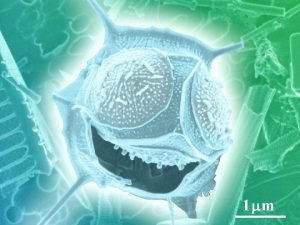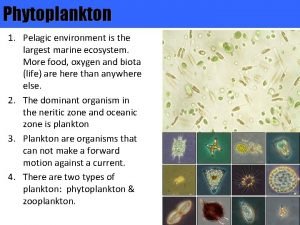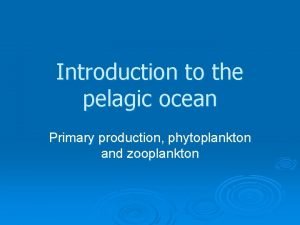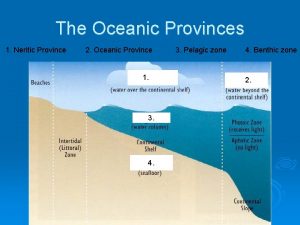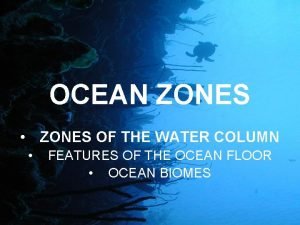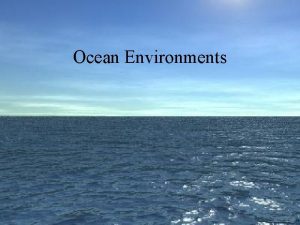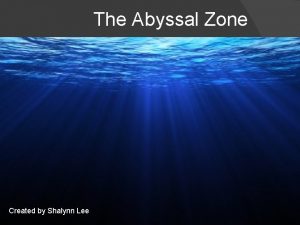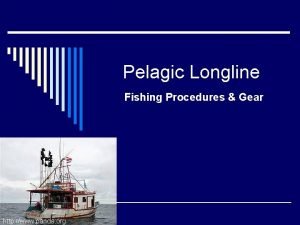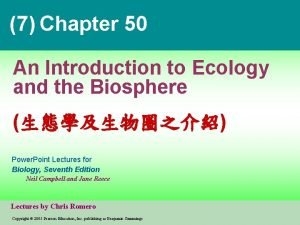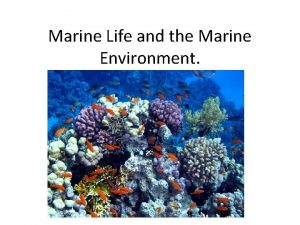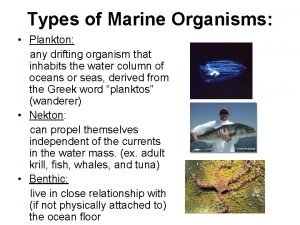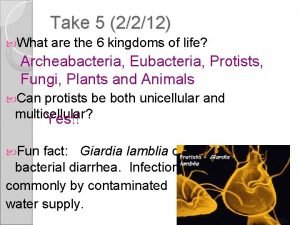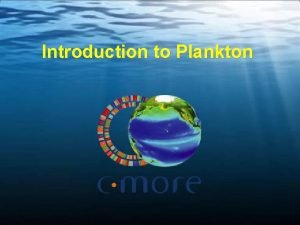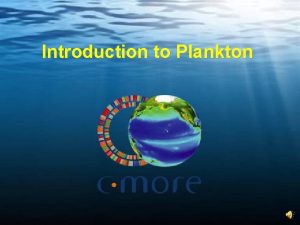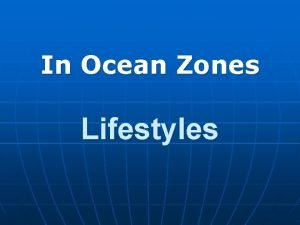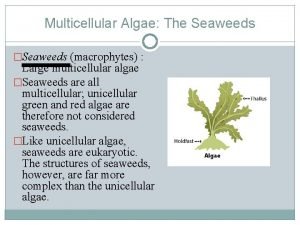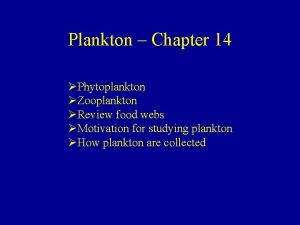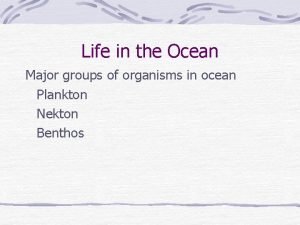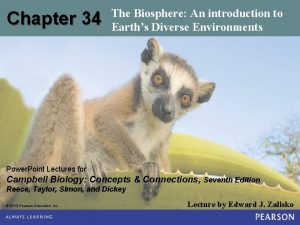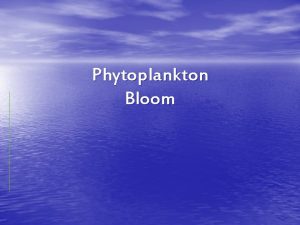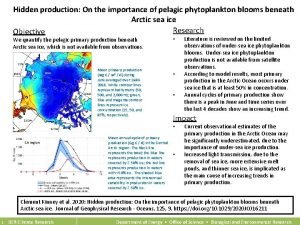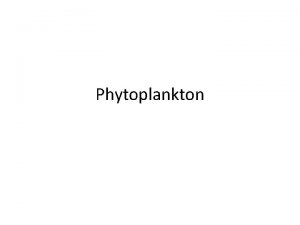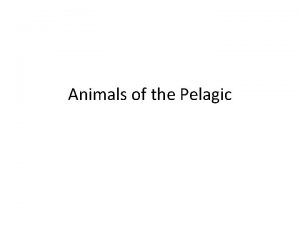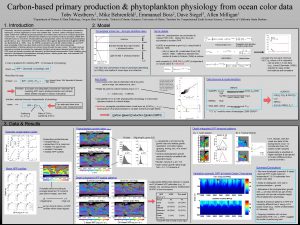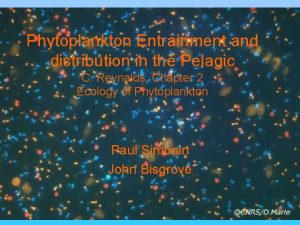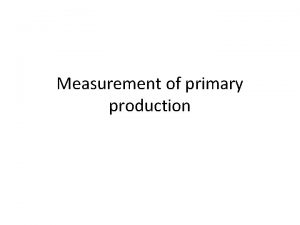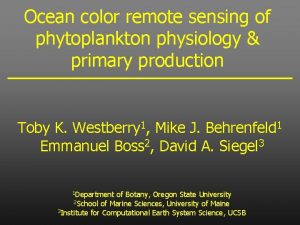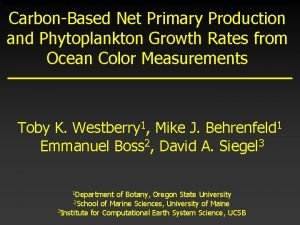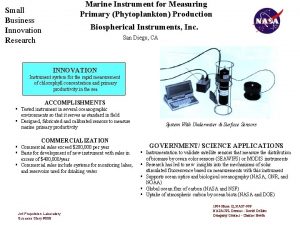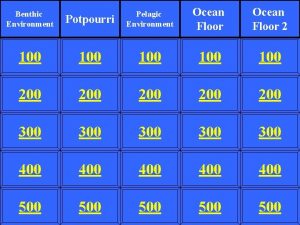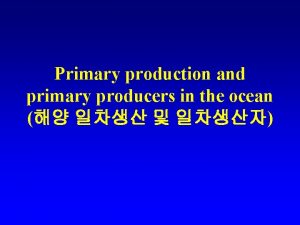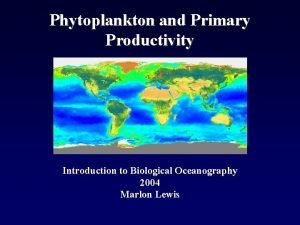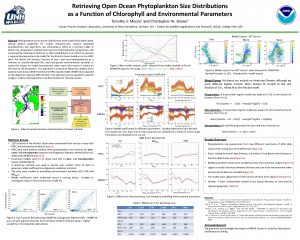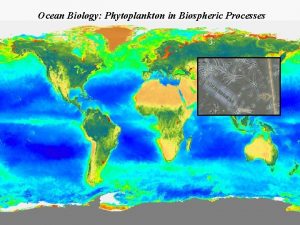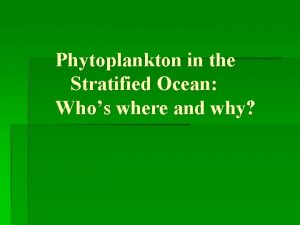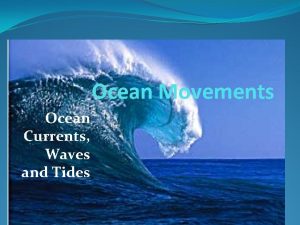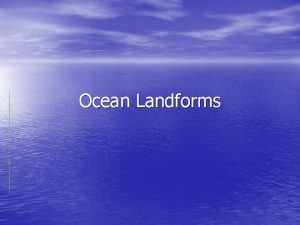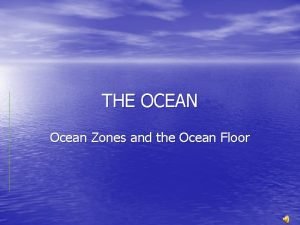Introduction to the pelagic ocean Primary production phytoplankton

























- Slides: 25

Introduction to the pelagic ocean Primary production, phytoplankton and zooplankton

Primary productivity Ø What is a primary producer? Ø What is photosynthesis? Ø What do you need to carry out photosynthesis Ø What are the products of primary production? Ø How do the land ocean compare?

June (2002) http: //www. globalcarbonproject. org/science/figures/FIGURE 9. htm December (2002) http: //www. globalcarbonproject. org/science/figures/FIGURE 9. htm

Phytoplankton Ø Primary producers (autotrophs) Ø Microscopic Ø ‘Plants’ of the ocean Ø Convert energy from the sun into organic carbon Ø Consumed by the higher trophic levels Ø Fuel the pelagic food web

The Plankton food web simplified CO 2 Phytoplankton Large zooplankton Nutrients Small zooplankton

The Energy Pyramid

Ø There are many different types Ø Cyanobacteria (Prokaryotic) l l Synechococcus Prochlorococcus Ø Eukaryotes l l Diatoms Dinoflagellates Coccolithophores Flagellates

Prokaryotes: Synechococcus Ø Cyanobacteria Ø Have phycoerythrin, a pigment with orange fluorescence Ø Significant in primary production worldwide, but more important in oligotrophic areas Ø Typically small Small (0. 8 -1. 5 μm) Ø Found solitary or in pairs http: //www. ibvf. cartuja. csic. es/Cul tivos/fotos/Synechococcus_PCC _7202_dis. jpg

Prochlorococcus Ø Cyanobacteria Ø Significant in primary production worldwide, but more important in oligotrophic areas Ø Contains divinyl derivatives of chlorophyll a and b Ø Picophytoplankton Ø Small (0. 5 -0. 8 μm) http: //proportal. mit. edu/images/mit 9215. jpg

Eukaryotes (the ones we will look at today) Diatoms Ø Incredibly important in coastal regions Ø Vary in size from a few um to over 1 mm Ø Silica frustule gives them widely varying shapes Ø Non-motile Ø Often form chains

Diatoms The silica frustule comes in widely varying morphologies Ø The silica frustule l l l Increases drag Decreases predation Cheap http: //www. bhikku. net/archives/03/img/diatoms. JPG

Diatoms Ø This leads to very different cell morphologies http: //www. discoverlife. org/nh/tx/Algae/image http: //starcentral. mbl. edu/microscope/port al. php? pagetitle=assetfactsheet&imageid s/Diatom. jpg. html http: //www. io-warnemuende. de/bio-ag=23592 phytoplankton-en. html http: //www. ldeo. columbia. edu/res/fac/micro/im ages. section/pages/diamtoms. html http: //www. urbanrivers. org/drawingdiat oms/diatom. jpg http: //kentsimmons. uwinnipeg. ca/16 cm 05/1116 /16 protists. htm

Dinoflagellates Ø Can be large, although they range a lot in size (5 -50 μm) Ø Can form blooms - Red Tides Ø Motile l l l Use two flagella Gives them the ability to avoid predators Or move up and down in water column in search of better nutrient or light conditions

Dinoflagellates http: //www. aad. gov. au/Asset/em_unit/images/dino 1. jpg http: //faculty. ccri. edu/lmfrolich/Microbiology/eukaryotes. htm http: //microscopy. bio. cmich. edu/images/SE Mgallery/SEMgallery 06. jpg http: //comenius. susqu. edu/BI/202/CHROMALVEOLAT A/ALVEOLATAE/DINOFLAGELLATA/CERATIUM. htm http: //www. pleasanton. k 12. ca. us/avhs web/thiel/creek/research/99/janelle/Pict ures/gony. jpg

Coccolithophores Ø Typically smaller than diatoms and dinoflagellates Ø Have Ca. CO 3 tests composed of multiple coccoliths Ø Form blooms over much of the Northern Atlantic Ø Emiliania huxleyi is an incredibly abundant species

http: //www. geo. uni-bremen. de/cocco/index. php? option=com_content&task=view&id=31&Itemid=47&lang=en

You can even see these guys from space Photo NASA http: //www. geo. unibremen. de/cocco/index. php? option=com_content&task=vie w&id=31&Itemid=47&lang=en

Flagellates Ø Grab bag of assorted others Ø Have a flagella Ø Typically small http: //starcentral. mbl. edu/microscope/ portal. php? pagetitle=getcollection&col lection. ID=171 http: //www. nilesbio. com/prod 149. html http: //www. orgs. muohio. edu/ uvlakes/UVecology/Protist/pr otozoa. html

The Plankton food web simplified CO 2 Phytoplankton Large zooplankton Nutrients Small zooplankton

Zooplankton Ø Heterotrophs Ø Primary or secondary consumers Ø Many shapes and sizes l l l Microscopic Very Large http: //www. break. com/usercontent/2007/8/Gia nt-Jellyfish-Swim-345642. html

Microzooplankton (small zoo’s) Ø Very small – microscopic Ø Usually protozoans Ø Many different groups l l l Ciliates Radiolarians Foraminifera

http: //www. divediscover. whoi. edu/expedition 10/dai ly/critter/images/tintinnids. jpg http: //www. pleasanton. k 12. ca. us/avhswe b/thiel/creek/research/99/janelle/Pictures/ nocti. jpeg http: //www. obs-vlfr. fr/gallery/Plankton. Protists/swimmimg_oligotrich_with_prey Photo: Mike Stukel http: //www. animalpicturesarchive. com/ view. php? tid=3&did=4131

Mesozooplankton (Large zoo’s) Ø Larger zooplankton (>200 um) Ø Metazoans Ø Many types: l l l Copepods Euphausiids Amphipods

Amphipod: Phronema PLANKTON!! Copepod: C. pacificus Euphausiid: E. pacifica Pelagic annelid: Tomopteris

Lab today Ø Observe different types of phytoplankton Ø Draw them and annotate one unique characteristic from each culture Ø Speculate on the ecological value of the characteristic Ø Guess what to which group each mystery phytoplankton belongs to. Ø Observe and draw a zooplankter Ø Annotate a unique characteristic Ø Discuss the plankton food web
 Pelagic phytoplankton
Pelagic phytoplankton Pelagic phytoplankton
Pelagic phytoplankton Pelagic phytoplankton
Pelagic phytoplankton Apa itu pre production
Apa itu pre production Hadopelagic
Hadopelagic Water column zones
Water column zones Pelagic zone
Pelagic zone Hadalpelagic zone
Hadalpelagic zone Temperature of abyssal zone
Temperature of abyssal zone Long line fishing kit
Long line fishing kit Photic zone
Photic zone Pelagic biome
Pelagic biome Pelagic zone
Pelagic zone Phytoplankton examples
Phytoplankton examples What eats phytoplankton
What eats phytoplankton Chrysophta
Chrysophta Where do phytoplankton live
Where do phytoplankton live Phytoplankton examples
Phytoplankton examples What zone is phytoplankton found
What zone is phytoplankton found Apakah alga multiseluler
Apakah alga multiseluler Is seaweed unicellular or multicellular
Is seaweed unicellular or multicellular Where do you find phytoplankton
Where do you find phytoplankton Holoplankton
Holoplankton Epifuana
Epifuana Phytoplankton
Phytoplankton Where do you find phytoplankton
Where do you find phytoplankton
